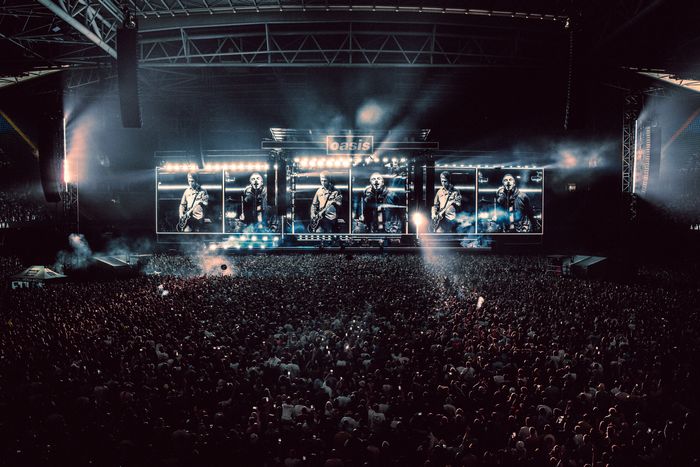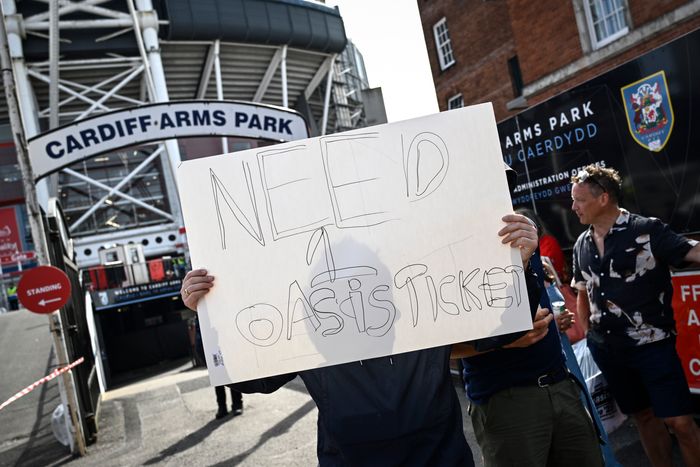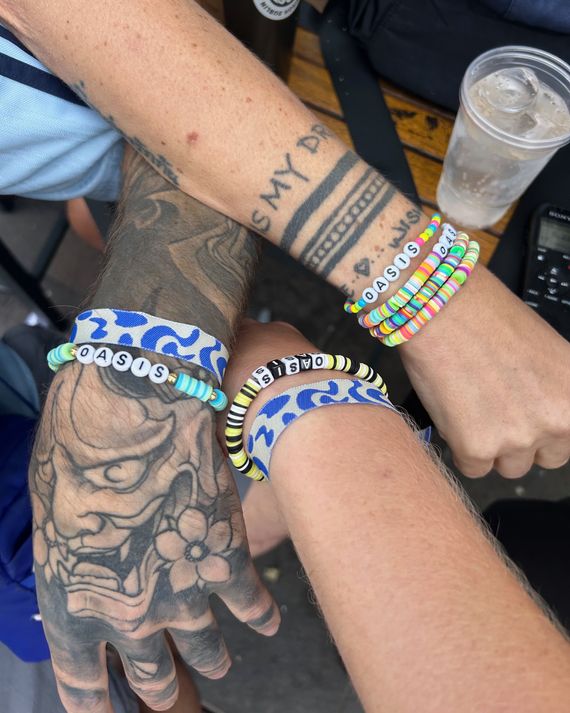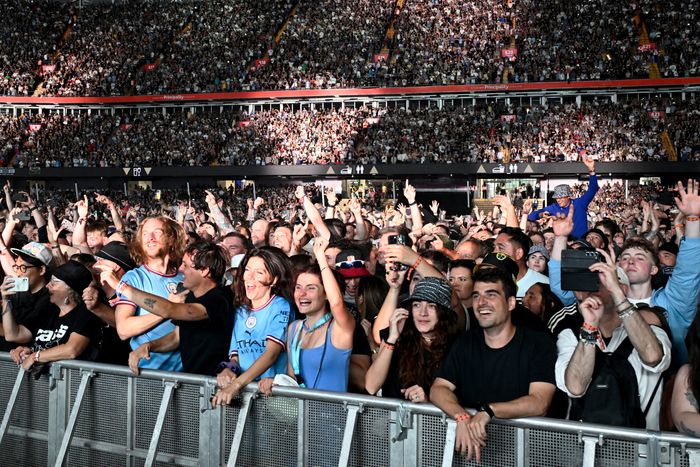Oasis Reunion Concert in Wales Review

Photo: Gareth Cattermole/Getty Images
“This is the biggest weekend of our lives,” Robbie Miller, an affable 32-year-old Scotsman, tells me in between gulps of lager. His friend Jordan Colligan concurs: “I don’t think people realize how big this actually is.” On this blustery, sun-dappled afternoon, the two friends are seated outside the Blue Bell pub in Cardiff, Wales, where they’ve been pregaming since 10 a.m. Eventually they’ll stroll down to Principality Stadium, joining the tens of thousands of other heads to see Oasis perform live. That Oasis.
The July 4th gig marks the first time Oasis has performed together since 2009, when the two brothers comprising the band’s core — lead vocalist/sometime tambourine player Liam Gallagher and songwriter/guitarist Noel Gallagher — had a backstage meltdown that involved Liam throwing a plum, then attempting to bonk Noel with a guitar, apparently “wielding it like an axe.” While that scuffle wasn’t entirely uncommon for the perpetually clashing Gallaghers, the incident ended with Oasis breaking up indefinitely. But after countless speculated reunions over the years, the brothers finally buried the guitar-shaped axe. Now they were set to play together for the first time in 16 years, with the initial stop happening here in Cardiff.
At any other concert, it’d be a little too on the nose for the audience to wear a T-shirt of the band to their show. But for Oasis’ first show back from the brink, donning band gear is less a prerequisite than a status symbol. The day of the gig, the seaside city is gripped by full-on Oasis-mania: Fans mill around in full Oasis-branded tracksuits. The energy is electric. “I’m so overstimulated,” a girl walking past me says. In the shadow of Cardiff Castle adjacent to the City Centre, bootleg merch sellers hawk John Lennon glasses and an extensive selection of £15 bucket hats spelling out Oasis song titles on them — “Some Might Say,” “Slide Away” — both sartorial Liam staples from the band’s ’90s heyday. Other hats feature cracks the brothers have made onstage and in colorful interviews, like “biblical” and “mad for it,” which have become lingua franca for their fanbase pining for the reunion. I almost go for one bucket hat that reads “Maybe” (pronounced “maybehhh,” i.e. the way Liam enunciates it in “Wonderwall”). Then I remember I’ve never worn a bucket hat in my life.
Miller and Colligan are both decked out in head-to-toe Oasis gear: T-shirts, bucket hats, and friendship bracelets spelling out the band’s name. The two had made fast friends of a couple they’d just met at the pub, who’d traveled from Italy for the show and were now doling out beaded bracelets that their 9-year-old daughter had made. The pair are Oasis diehards: “I promised him one day, we will see them together,” Claudia Zarucchi says, beaming at her husband. They offer me a friendship bracelet, with a caveat: Their kid wants a little cash for her labor. Respecting the hustle, I fork over two bucks for this small business. The pair also have a twelve-year old son. His name is Noel.
Photo: Josh Halling
Hailing from just outside Manchester, England, Oasis became a cultural phenomenon in the early 1990s by zigging when other musicians were zagging. Their predilection for stadium-ready riffs felt out of step with the acid-drenched dance music dominating their neck of Northern England at the time; their flagrant cribbing of Beatles-inflected psychedelia happened right when grunge had a firm hold on U.S. radio. Oasis’ debut album Definitely Maybe shot straight to No. 1 in the UK upon its release, and their follow-up (What’s the Story) Morning Glory? went nuclear with hits like “Wonderwall” and “Champagne Supernova.” That one-two punch cemented them as boisterous capital-R rock giants and their songs became a ubiquitous presence at karaoke bars around the world.
But power chords alone did not cause Oasis to transcend into a once-in-a-generation act, the brothers’ tense dynamic did. Liam sang most of the songs in his reedy yowl, all charisma with his hands pulled behind his back, head tilted up towards the sky and a parka often inexplicably zipped all the way up to his chin. The band’s resident wordsmith, Noel, looked like he’d just stepped out of a ’60s time machine with long sideburns and a mop top. Onstage he nimbly wailed on the guitar, lending his voice on harmonies and occasionally singing heartrending numbers of his own. The Gallaghers needed each other, in other words, to pull the whole thing off — if only they could get past the rivalry that began when they were forced to share a room as kids. Their beef frequently manifested in public, with insults that ranged from cutting to hysterical in the press, sometimes tipping into more violent incidents, including one involving a cricket bat. After their breakup, Liam and Noel both went on to release solo projects but continued to talk shit about one another, particularly online. Liam has been known to refer to his elder sibling as “Potato” on X and Noel once groused in an interview that Liam was “a man with a fork in a world of soup.” Fueled by the pent-up lore, Oasis in absentia has arguably become bigger than they were even in the ‘90s. The Umbro jumpers Liam used to wear have become coveted on Depop and the Gallaghers’ shaggy haircuts might be outpacing mullets as the do du jour in some major cities.
Still, longtime fans had resigned themselves to watching grainy clips on YouTube, concluding that the resentment between the Gallaghers ran too deep to ever prompt a reunion. So when Oasis unexpectedly announced a reunion last year, frenzy ensued. Tickets sold out in minutes for all legs of the tour, which would kick off in the UK and make its way to North and South America, Asia, and Australia in fall 2025. To give a sense of how coveted these tickets are, one estimate holds that 14 million people tried to nab spots for the UK shows — as many people who signed up for Taylor Swift’s Eras tour pre-sale tickets. I stayed up until 3 a.m. the day tickets went on sale, struggling through various queues on several different laptops until I somehow snapped up four tickets for the first show in Cardiff. Miller and Colligan snagged theirs through a friend in Australia, who is running around here somewhere. Some people even pulled the trigger on multiple Oasis dates, including Colin Carhart from Asbury Park, New Jersey. He’s seeing Oasis tonight and tomorrow, also in Cardiff. “There’s no way I was going to miss this,” he says. I meet more than a few American fans and a handful of Canadians, and hear people in Oasis tees speaking in Japanese, Spanish, Mandarin, Welsh, and Portuguese. Sam Lau, a fan who’d come in from Hong Kong the night before, beelined from the train station to buy Oasis merch. The day before, I’d spotted a gaggle of French fans busting out their camping gear, sleeping outside the stadium so they could get a good spot in standing room.
Photo: Gareth Cattermole/Getty Images
As it gets closer to doors at 5 p.m. the pubs surrounding the venue are so rammed with fans that they spill out into the narrow street. Some turn people away from the sheer volume. A busker outside the Tiny Rebel bar strums “Don’t Look Back in Anger” to scores of onlookers, drumming up even more hype before people stream inside. We head into the stadium an hour later, surprised by how quick it is to get through security. Heading up the stairs, a kid who can’t be older than eight is with his dad. I ask them who’s the bigger Oasis fan. His hand instantly shoots up: “Me!” We don’t have the greatest view, off to the side to the right of the stage, but good sightlines are beside the point here. Everyone around us hums with nervous anticipation.
Things start going a little off the rails around the time the show’s second opener, Richard Ashcroft, of The Verve, waves the crowd goodbye after ending his set around 7:45 pm. My fiancé spots a man who can barely stand but is still attempting to carry eight pints of beer up to his seat. The family behind me yells at a group of teens trying to smoke a cigarette inside. A fight almost breaks out four rows down after a man flicks someone else off, but the lads make peace before the main event.
At 8:13 pm, the Beatles’ “Tomorrow Never Knows” starts blaring a hair louder than the other pre-show songs. From our nosebleeds we can see behind the stage, and catch a glimpse of Noel striding up the side. Liam isn’t far behind him, doing his distinctively silly cock-walk up to the stage. When they make their way in front of the crowd right at 8:15, as promised, everyone bellows at a volume I hadn’t ever heard before at a stadium show. This is suddenly real.
Perhaps in a bid to keep the band together through the end of the tour, Liam and Noel banter very little onstage, preferring to swiftly run through the songs. (Though at one point Liam thanked the crowd thusly: “Nice one for putting up with us over the years.”) The band plays a smattering of de rigueur Oasis cuts for this first show, a la “Rock ’n’ Roll Star” and “Supersonic,” mostly from their first two albums. The setlist is interspersed with some b-sides and unexpected choices like “Fade Away” and the rabble rousing “D’You Know What I Mean” from their cocaine-fueled third album, Be Here Now. The crowd screams along to every word. Bro hugs between strangers abound. It’s balmy inside the stadium but a guy a few rows over from us keeps his parka pulled up tight, naturally. I’m a little jealous of the people who managed to get standing room tickets, though seeing everyone bounce in unison to the barnburner “Slide Away” from above is a wild sight.
Photo: Paula Mejía
The band sounds locked in, especially after the first few numbers, the songs crisp and sonorous in the cavernous space. Liam’s nasal-tinged vocals resound damn near the same as they did on records from thirty years ago, and Noel’s shredding feels somehow even more massive. Almost no one sits down over the course of two-plus hours. After a brief encore, the guys come back out for several of their biggest numbers, “Don’t Look Back in Anger,” “Wonderwall,” and “Champagne Supernova,” which elicit the biggest singalongs of the night. The Gallaghers end it by gamely fist bumping and briefly hugging it out before walking off. In a perfectly rock star move, Liam gets into a Range Rover that had pulled into the stadium near the side of the stage, doors open, that swiftly whisks him away into the night. Noel prefers to walk out alone, waving to the roaring crowd leaving.
After the show lets out, the fanfare is somehow even more pronounced. A few fans we chat with by the bathrooms, who’d seen Oasis back in the ‘90s, are already plotting on how to get tickets to future shows on this tour. While no one knew quite what to expect from this reunion, I’d venture to say that most people were happy to be here regardless of the show’s quality. That Oasis actually delivered only made people even more feral; the consensus among everyone we run into is that they’ve never sounded better. My brother and his wife, who’d also traveled from Brooklyn for the show, are so moved by the experience that they end up posting their pregnancy reveal on Instagram after snapping a photo of themselves from our seats: “Baby’s first concert.”
Photo: Gareth Cattermole/Getty Images
No one wants to leave. Fans mob the surrounding streets, trudging back into pubs and bustling clubs on the high street. An industrious man has set up a mobile karaoke stand in the middle of one road, where a fan is already belting “Stand by Me.” We stop for late-night gyros and meet two longtime friends, Mark Brown and David O’Brien. This is the first of seven Oasis shows Brown is seeing — he’s going to two gigs in Manchester, another two in London, one in Dublin, and one in New York. When I ask him how much he spent on tickets alone, he smiles bashfully. “I haven’t properly calculated it, but it’s a lot,” he admits. Brown had seen Oasis back in the day but says this was easily the best they’d sounded, which he attributes to “the build up, not knowing what to expect, and hearing how fucking good they were.”
This show means a lot to both Brown and O’Brien. They brought a Union Jack to the show with them, to which they’d pinned the Oasis logo and a small purple ribbon commemorating their friend Liam Howell, who died last year at the age of 36. They had all gone to see Oasis together in Manchester in 2009, but Howell didn’t make it to the show — he got so excited that he drank a little too much and missed it altogether. “There was some part of him here with us” tonight, O’Brien says. “It’d have been amazing having here. He’d have been here, he’d have gone home before the gig,” Brown laughs. Brown managed to snag a few extra tickets to one of the Oasis shows at Wembley Stadium in a few weeks, and he’s bringing Howell’s siblings with him.
Both O’Brien and Brown both grew up in Bradford, near the Gallaghers’ hometown around Manchester. To them, Oasis are “central to how we are,” O’Brien says. The Gallaghers were “working class lads” who “had fuck-all growing up,” Brown says. “I think that’s why we’re drawn to them. “Very relatable,” O’Brien nods. “I’ve waited 20 years for this gig.”








